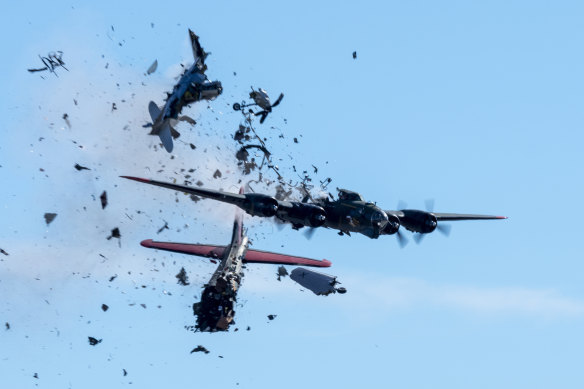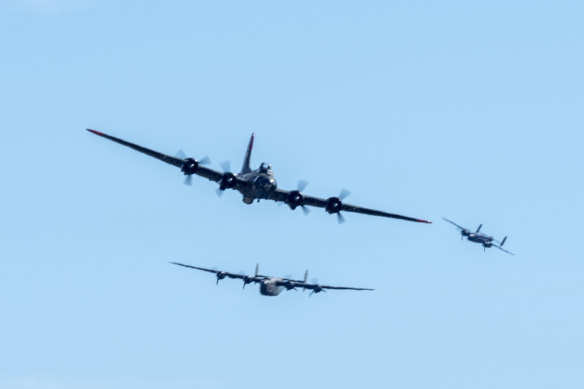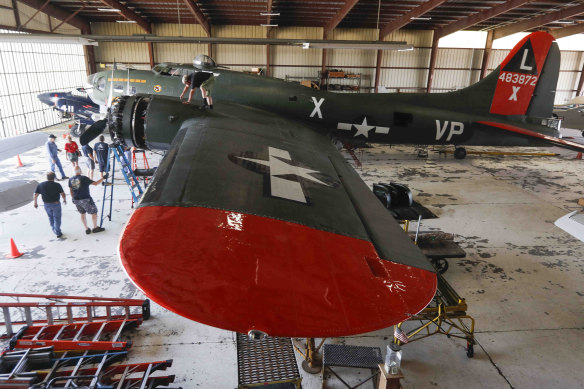ByJuan Lozano and Josh Funk
November 14, 2022 —
Dallas: A national transportation official probing the cause of a midair crash of two historic military planes during an air show that left six people dead said that one of the key questions for investigators is why the aircraft were seemingly sharing the same space just before impact.
A World War II-era bomber and a fighter plane collided and crashed to the ground in a ball of flames on Saturday, leaving crumpled wreckage in a grassy area inside the Dallas Executive Airport perimeter, about 16 kilometres from the city’s downtown. New images released on Monday showed the moments before and after the fighter plane crashed into the bomber.

Photos show the moments after a Boeing B-17 Flying Fortress and a Bell P-63 Kingcobra collide in midair during an airshow at Dallas Executive Airport.CREDIT:AP
“One of the things we would probably most likely be trying to determine is why those aircraft were co-altitude in the same air space at the same time,” Michael Graham, a member of the National Transportation Safety Board, said at a news conference.
The crash came three years after the crash of a bomber in Connecticut that killed seven, and amid ongoing concern about the safety of air shows involving older warplanes. The company that owned the planes flying in the Wings Over Dallas show has had other crashes in its more than 60-year history.
The crash claimed six lives, Dallas County Judge Clay Jenkins tweeted on Sunday, citing the county medical examiner. Authorities are continuing work to identify the victims, he said. Dallas Fire-Rescue said there were no reports of injuries on the ground.
Armin Mizani, the mayor of Keller, Texas, said Terry Barker, a retired pilot who lived in Keller, was in the B-17 bomber that crashed. Mizani said he learned of Barker’s death from his family.

A Boeing B-17 Flying Fortress, front, is seen seconds before colliding with a Bell P-63 Kingcobra in Dallas.
CREDIT:AP
Mizani said Barker’s death has been difficult for his town of 50,000, where many of the residents know each other.
“It’s definitely a big loss in our community,” he said. “We’re grieving.”
Barker was an Army veteran who flew helicopters during his military service. He later worked for American Airlines for 36 years before retiring in 2020, Mizani said.
Maj. Curtis J. Rowe, a member of the Ohio Wing Civil Air Patrol, was a crew chief on the B-17, his brother-in-law Andy Keller told The Associated Press on Sunday. Rowe, of Hilliard, Ohio, did air shows several times a year because he fell in love with WWII aircraft, Keller said.
The Federal Aviation Administration also was going to investigate, officials said. The planes collided and crashed about 1.20pm, the FAA said.
Mizani said Barker’s death has been difficult for his town of 50,000, where many of the residents know each other.
“It’s definitely a big loss in our community,” he said. “We’re grieving.”
Barker was an Army veteran who flew helicopters during his military service. He later worked for American Airlines for 36 years before retiring in 2020, Mizani said.
Maj. Curtis J. Rowe, a member of the Ohio Wing Civil Air Patrol, was a crew chief on the B-17, his brother-in-law Andy Keller told The Associated Press on Sunday. Rowe, of Hilliard, Ohio, did air shows several times a year because he fell in love with WWII aircraft, Keller said.
The Federal Aviation Administration also was going to investigate, officials said. The planes collided and crashed about 1.20pm, the FAA said.

The World War II-era B-17 Flying Fortress involved in the crash, pictured in June 10, 2021.CREDIT:AP
Graham said five people were in the B-17 Flying Fortress bomber and a pilot was the only person in the P-63 Kingcobra fighter plane. The aircraft are owned by Commemorative Air Force, the company that put on the air show. The aircraft are flown by highly trained volunteers, often retired pilots, said Hank Coates, president of Commemorative Air Force.
John Cudahy is president of the International Council of Air Shows, a trade group that sets the standards air shows follow and oversees the training of pilots and “air bosses,” who serve as the flight controller for an event. Cudahy said that typically at air shows there is a Friday rehearsal where the pilots fly through the entire show to practice, so the Saturday show is actually the second time the pilots have flown the show. There are also detailed briefings each day to go over the plan for the air show and cover exactly where each pilot will be and their roles in the show.
“It’s still to early to figure out what happened yesterday. I’ve watched the tape several times and I can’t figure it out and I’ve been doing this for 25 years,” Cudahy said.
Investigators will examine the wreckage from both aircraft, conduct interviews of crews present at the air show and obtain pilot training and aircraft maintenance records.
“We’ll look at everything that we can and we’ll let the evidence basically lead us to the appropriate conclusions. At this point, we will not speculate” on the cause, Graham said.
A preliminary report from the NTSB is expected in four to six weeks, while a final report will take up to 18 months to complete.
Air shows must obtain special waivers from the FAA and all of the pilots have to demonstrate their skills in low flying and other manoeuvres used in air shows, said John Cox, a former airline captain with more than 50 years’ experience. Cox is also founder of Safety Operating Systems, a company that helps smaller airlines and corporate flight services from around the world with safety planning.
Each air show is overseen by an air boss, Cox said.
“If there’s any adjustments that have to be made, it’s the air boss that makes those calls and the pilots comply with that,” he said. In addition, any pilot with a mechanical problem would announce it to the air boss, he said.
Air shows typically rely on extremely detailed plans, including contingencies for emergencies, Cox said. For example, any pilot who ran into trouble could break out of formation and go to a designated area free of other planes that is identified by a landmark of some kind.
The B-17, a cornerstone of US air power during World War II, is an immense four-engine bomber used in daylight raids against Germany. The Kingcobra, a US fighter plane, was used mostly by Soviet forces during the war. Most B-17s were scrapped at the end of World War II and only a handful remain today, largely featured at museums and air shows, according to Boeing.
The Commemorative Air Force has had previous crashes during its more than 60-year history, including a deadly 1995 crash near Odessa, Texas, involving a B-26 bomber that killed five crewmembers, according to an NTSB report. The plane crashed while practicing for an air show. The NTSB determined that the probable cause was the failure of the pilot to maintain minimum airspeed for flight.
In 2001, two separate West Texas crashes involving planes owned by the group – one in April and one in May – killed three people. In June 2005, two people were killed when a single-engine plane owned by the group crashed in Williamson, Georgia.
The Commemorative Air Force, previously called the Confederate Air Force until members changed its name in 2001 to avoid any association with the Civil War, had been headquartered in Midland, Texas, but relocated to Dallas in 2014.
Wings Over Dallas bills itself as “America’s Premier World War II Airshow,” according to a website advertising the event. The show was scheduled for November 11-13, Veterans Day weekend, and guests were to see more than 40 World War II-era aircraft. Its Saturday afternoon schedule of flying demonstrations included the “bomber parade” and “fighter escorts” that featured the B-17 and P-63.
AP
No comments:
Post a Comment